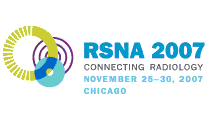
Abstract Archives of the RSNA, 2007
SSM06-06
Transient Hepatic Signal Intensity Differences (THID) Surrounding Focal Hepatic Lesions in Non-Cirrhotic Patients: Prevalence and Characterization with 1.5T-MR Imaging Using Hepatospecific Medium Contrast
Scientific Papers
Presented on November 28, 2007
Presented as part of SSM06: Gastrointestinal (Liver: Focal Lesions)
Mariapina Milazzo, Abstract Co-Author: Nothing to Disclose
Tommaso Vincenzo Bartolotta MD, Abstract Co-Author: Nothing to Disclose
Gianluca Marrone MD, Abstract Co-Author: Nothing to Disclose
Massimo Midiri MD, Abstract Co-Author: Nothing to Disclose
Angelo Luca MD, Presenter: Nothing to Disclose
Marcello De Maria MD, Abstract Co-Author: Nothing to Disclose
To define the prevalence and the diagnostic significance of THID surrounding hepatic lesions in non-cirrhotic patients.
A total of 263 non-cirrhotic patients underwent a liver MR investigation in a single center. The study was performed using 1.5T equipment and 8-channel body coil. The following sequences were used: T1-weighted 2D (in-phase) GRE, T1-weighted 3D (out-of-phase) GRE, T1-weighted fat sat, T2-weighted HASTE, T2-weighted fat sat, triple-phase contrast-enhanced images followed by acquisition 2 hours after Gd-BOPTA (Multihance, Bracco). Patients with uncommon hepatic lesions or >10 lesions were excluded. The signal intensity of THID was analyzed and correlated to the characteristics (type, histology, size, lobar distribution, vascular hepatic infiltration, and bile duct dilatation) and nature (benign vs. malignant) of the hepatic lesions.
A total of 110/213 (52%) patients had THID surrounding hepatic lesions. THID were detected in 60/87 (69%) patients with metastases, 27/52 (52%) with hemangiomas, 11/17 (65%) with cholangiocarcinomas, 10/31 (32%) with FNH, and 2/26 (8%) with cysts. THID occurred in 51/88 (58%) patients with bilobar disease, 18/21 (86%) with portal vein thrombosis, 19/24 (79%) with hepatic vein thrombosis, 4/6 (67%) with encasement of hepatic artery, and 27/35 (77%) with bile ducts dilatation. THID were more common in patients with larger lesions. Hypointensity on unenhanced T1-weighet images and on images acquired 2 hours after BOPTA administration was detected in 12% and 26% of THID, respectively; in all these cases THID surrounded malignant lesions.
THID surrounding benign and malignant hepatic lesions in non-cirrhotic patients are common findings at the MRI examination. The prevalence of THID is significantly higher in malignant lesions, lesions with larger size, bilobar distribution, hepatic vascular infiltration and bile ducts dilatation. THID characteristics may help to exclude the benign nature of hepatic lesion.
These data are useful for the diagnosis of focal hepatic lesions with THID in non-cirrhotic patients.
Milazzo, M,
Bartolotta, T,
Marrone, G,
Midiri, M,
Luca, A,
De Maria, M,
Transient Hepatic Signal Intensity Differences (THID) Surrounding Focal Hepatic Lesions in Non-Cirrhotic Patients: Prevalence and Characterization with 1.5T-MR Imaging Using Hepatospecific Medium Contrast. Radiological Society of North America 2007 Scientific Assembly and Annual Meeting, November 25 - November 30, 2007 ,Chicago IL.
http://archive.rsna.org/2007/5004943.html

